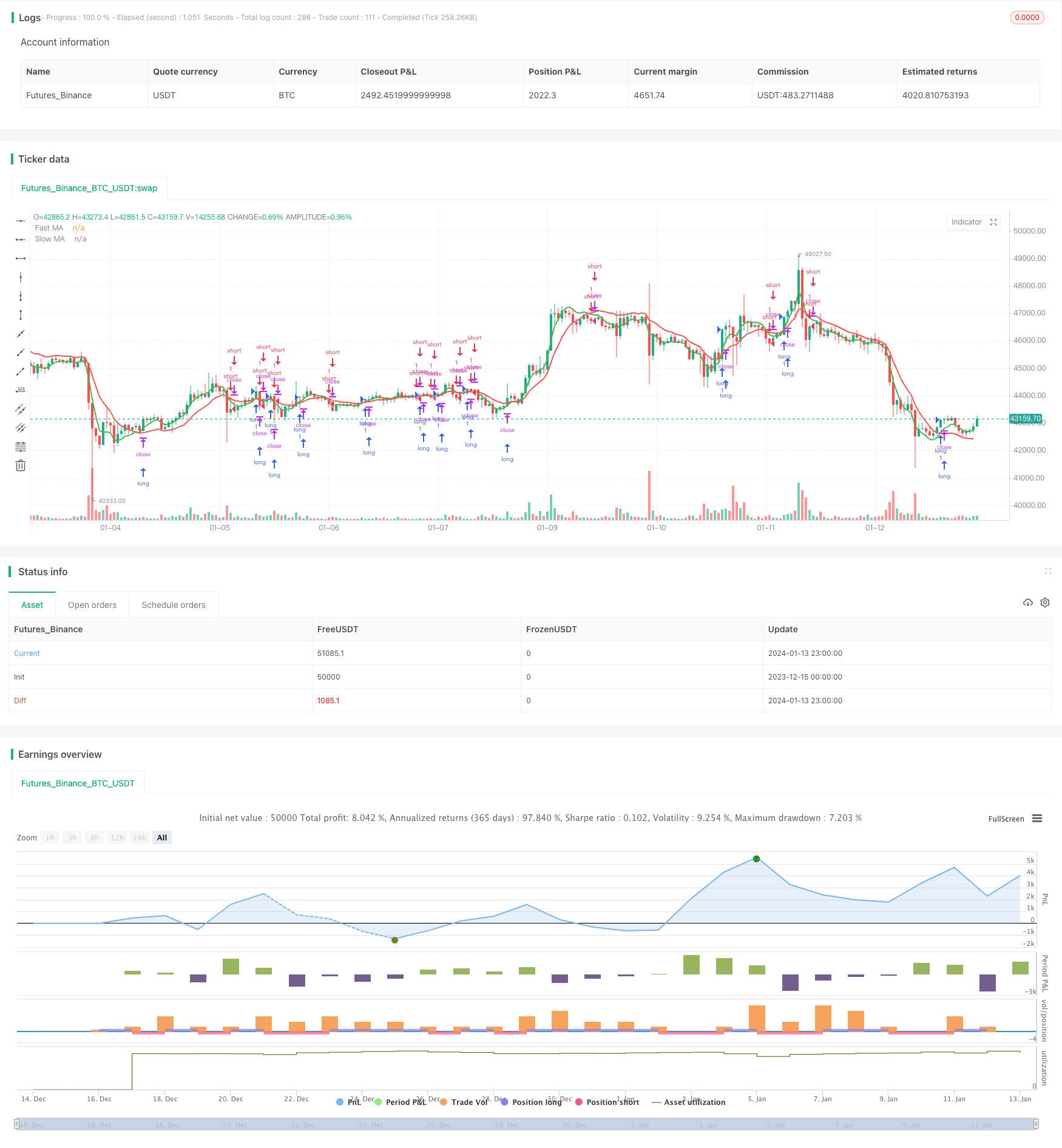
概述
该策略组合使用了11种不同类型的移动平均线的交叉来进行做多和做空。使用的11种移动平均线包括:简单移动平均线(SMA)、指数移动平均线(EMA)、加权移动平均线(WMA)、成交量加权移动平均线(VWMA)、平滑移动平均线(SMMA)、双指数移动平均线(DEMA)、三次指数移动平均线(TEMA)、赫尔移动平均线(HMA)、零滞后指数移动平均线(ZEMA)、三角移动平均线(TMA)和超平滑过滤器(SSMA)。
该策略允许配置两个移动平均线——一个较快的和一个较慢的,都从11种选择中选择。当较快的MA交叉超过较慢的MA时,会生成做多信号。当较快的MA交叉低于较慢的MA时,会生成做空信号。
附加功能包括梯形设置、止盈和止损水平。
策略逻辑
核心策略逻辑依赖于两个移动平均线之间的交叉来确定进入和退出。
进入条件是:
做多入场:快速MA > 慢速MA
做空入場:快速MA < 慢速MA
退出由以下三个标准中的一个确定:
- 止盈水平达到
- 止损水平达到
- 生成相反信号(移动平均线以相反方向交叉)
该策略允许配置关键参数,如MA类型和长度、梯形设置、止盈和止损百分比。这为根据不同的市场条件和风险偏好优化策略提供了灵活性。
优势
- 结合11种不同的MA类型以产生强大信号
- 主要参数配置灵活
- 止盈和止损功能保护利润、限制损失
- 梯形允许强势趋势中增加仓位
风险
- 和任何技术指标一样,MA交叉可能会生成错误信号
- 过度优化当前市场条件可能降低未来表现
- 硬止损过早退出了波动大的正确交易
可以通过为入场信号使用价位确认、使用追踪止损而不是硬止损以及避免过度优化来加强风险管理。
优化空间
可以通过几种方式改进该策略:
- 在入场前加入额外过滤器,如成交量和价位检查
- 系统地测试不同MA类型的表现,选择最佳的1-2种
- 针对特定交易品种和时间段优化MA长度
- 使用追踪止损替代硬止损
- 随着趋势加长添加分阶段止盈
总结
十一条移动平均线交叉策略提供了一种系统化交易交叉的方法。通过结合跨多种MA指标的信号并允许配置关键参数,它提供了一个强大且灵活的交易框架。优化和风险管理将发挥关键作用,以优化表现。该策略在动量交易中具有很强的潜力,但应根据不同的市场环境进行调整。
策略源码
/*backtest
start: 2023-12-15 00:00:00
end: 2024-01-14 00:00:00
period: 1h
basePeriod: 15m
exchanges: [{"eid":"Futures_Binance","currency":"BTC_USDT"}]
*/
//@version=3
strategy(title = "[STRATEGY] MA Cross Eleven", overlay = true)
// MA - type, source, length
// MA - type, source, length
// SMA --> Simple
// EMA --> Exponential
// WMA --> Weighted
// VWMA --> Volume Weighted
// SMMA --> Smoothed
// DEMA --> Double Exponential
// TEMA --> Triple Exponential
// HMA --> Hull
// TMA --> Triangular
// SSMA --> SuperSmoother filter
// ZEMA --> Zero Lag Exponential
type = input(defval="ZEMA", title="MA Type: ", options=["SMA", "EMA", "WMA", "VWMA", "SMMA", "DEMA", "TEMA", "HullMA", "ZEMA", "TMA", "SSMA"])
len1 = input(defval=8, title="Fast MA Length", minval=1)
srcclose1 = input(close, "Fast MA Source")
len2 = input(defval=21, title="Slow MA Length", minval=1)
srcclose2 = input(close, "Slow MA Source")
// Returns MA input selection variant, default to SMA if blank or typo.
variant(type, src, len) =>
v1 = sma(src, len) // Simple
v2 = ema(src, len) // Exponential
v3 = wma(src, len) // Weighted
v4 = vwma(src, len) // Volume Weighted
v5 = 0.0
v5 := na(v5[1]) ? sma(src, len) : (v5[1] * (len - 1) + src) / len // Smoothed
v6 = 2 * v2 - ema(v2, len) // Double Exponential
v7 = 3 * (v2 - ema(v2, len)) + ema(ema(v2, len), len) // Triple Exponential
v8 = wma(2 * wma(src, len / 2) - wma(src, len), round(sqrt(len))) // Hull
v11 = sma(sma(src,len),len) // Triangular
// SuperSmoother filter
// © 2013 John F. Ehlers
a1 = exp(-1.414*3.14159 / len)
b1 = 2*a1*cos(1.414*3.14159 / len)
c2 = b1
c3 = (-a1)*a1
c1 = 1 - c2 - c3
v9 = 0.0
v9 := c1*(src + nz(src[1])) / 2 + c2*nz(v9[1]) + c3*nz(v9[2])
// Zero Lag Exponential
e = ema(v2, len)
v10 = v2+(v2-e)
// return variant, defaults to SMA if input invalid.
type=="EMA"?v2 : type=="WMA"?v3 : type=="VWMA"?v4 : type=="SMMA"?v5 : type=="DEMA"?v6 : type=="TEMA"?v7 : type=="HullMA"?v8 : type=="SSMA"?v9 : type=="ZEMA"?v10 : type=="TMA"? v11: v1
ma_1 = variant(type, srcclose1, len1)
ma_2 = variant(type, srcclose2, len2)
plot(ma_1, title="Fast MA", color = green, linewidth=2, transp=0)
plot(ma_2, title="Slow MA", color = red, linewidth=2, transp=0)
longCond = na
shortCond = na
longCond := crossover(ma_1, ma_2)
shortCond := crossunder(ma_1, ma_2)
// Count your long short conditions for more control with Pyramiding
sectionLongs = 0
sectionLongs := nz(sectionLongs[1])
sectionShorts = 0
sectionShorts := nz(sectionShorts[1])
if longCond
sectionLongs := sectionLongs + 1
sectionShorts := 0
if shortCond
sectionLongs := 0
sectionShorts := sectionShorts + 1
// Pyramiding Inputs
pyrl = input(1, "Pyramiding")
// These check to see your signal and cross references it against the pyramiding settings above
longCondition = longCond and sectionLongs <= pyrl
shortCondition = shortCond and sectionShorts <= pyrl
// Get the price of the last opened long or short
last_open_longCondition = na
last_open_shortCondition = na
last_open_longCondition := longCondition ? high[1] : nz(last_open_longCondition[1])
last_open_shortCondition := shortCondition ? low[1] : nz(last_open_shortCondition[1])
// Check if your last postion was a long or a short
last_longCondition = na
last_shortCondition = na
last_longCondition := longCondition ? time : nz(last_longCondition[1])
last_shortCondition := shortCondition ? time : nz(last_shortCondition[1])
in_longCondition = last_longCondition > last_shortCondition
in_shortCondition = last_shortCondition > last_longCondition
// Take profit
isTPl = input(false, "Take Profit Long")
isTPs = input(false, "Take Profit Short")
tpl = input(3, "Take Profit Long %", type=float)
tps = input(30, "Take Profit Short %", type=float)
long_tp = isTPl and crossover(high, (1+(tpl/100))*last_open_longCondition) and in_longCondition == 1
short_tp = isTPs and crossunder(low, (1-(tps/100))*last_open_shortCondition) and in_shortCondition == 1
// Stop Loss
isSLl = input(false, "Stop Loss Long")
isSLs = input(false, "Stop Loss Short")
sl= 0.0
sl := input(3, "Stop Loss %", type=float)
long_sl = isSLl and crossunder(low, (1-(sl/100))*last_open_longCondition) and longCondition == 0 and in_longCondition == 1
short_sl = isSLs and crossover(high, (1+(sl/100))*last_open_shortCondition) and shortCondition == 0 and in_shortCondition == 1
// Create a single close for all the different closing conditions.
long_close = long_tp or long_sl ? 1 : 0
short_close = short_tp or short_sl ? 1 : 0
// Get the time of the last close
last_long_close = na
last_short_close = na
last_long_close := long_close ? time : nz(last_long_close[1])
last_short_close := short_close ? time : nz(last_short_close[1])
// Strategy entries
strategy.entry("long", strategy.long, when=longCondition == true, stop = open[1])
strategy.entry("short", strategy.short, when=shortCondition == true)
strategy.close("long", when = long_sl or long_tp)
strategy.close("short", when = short_sl or short_tp)